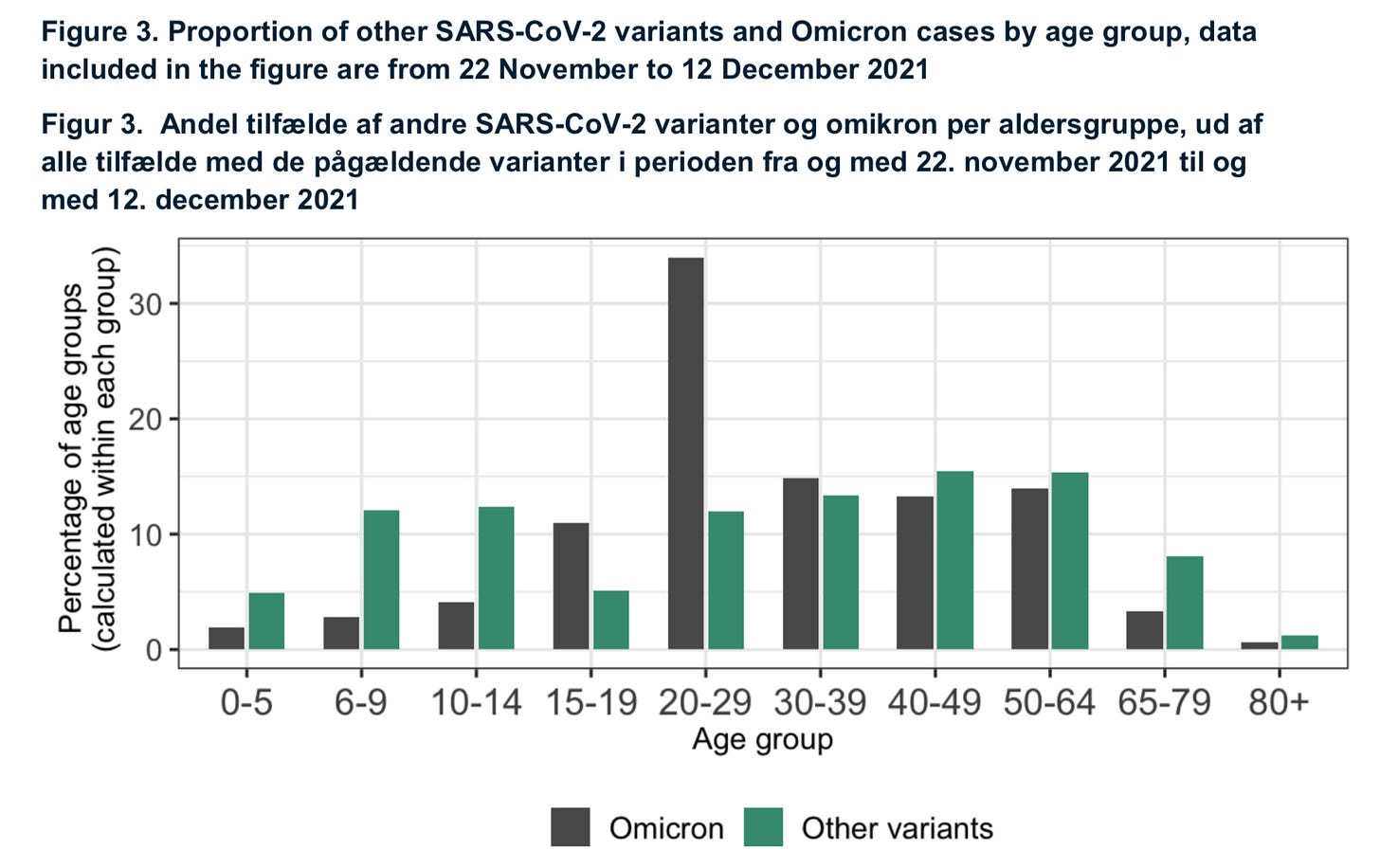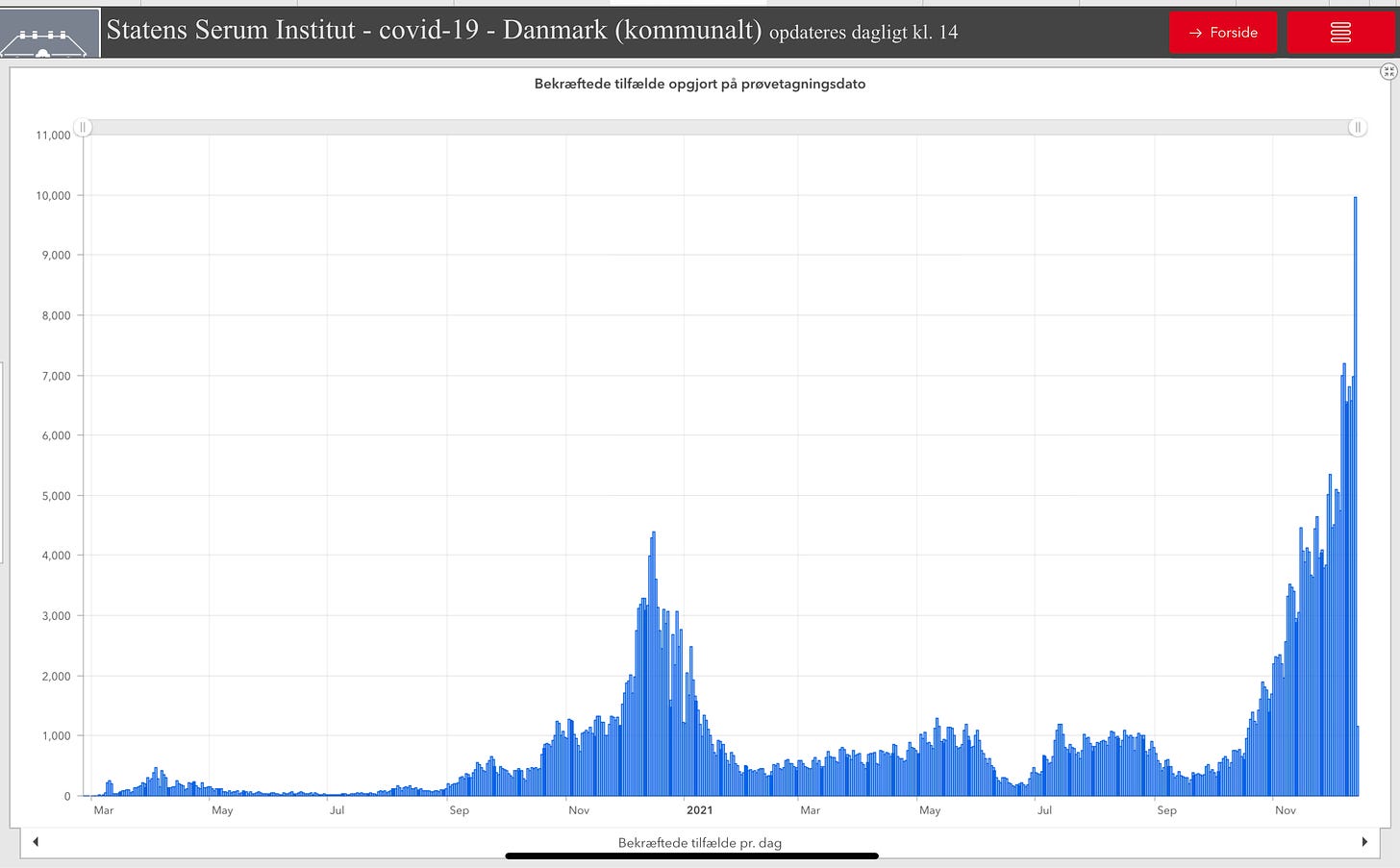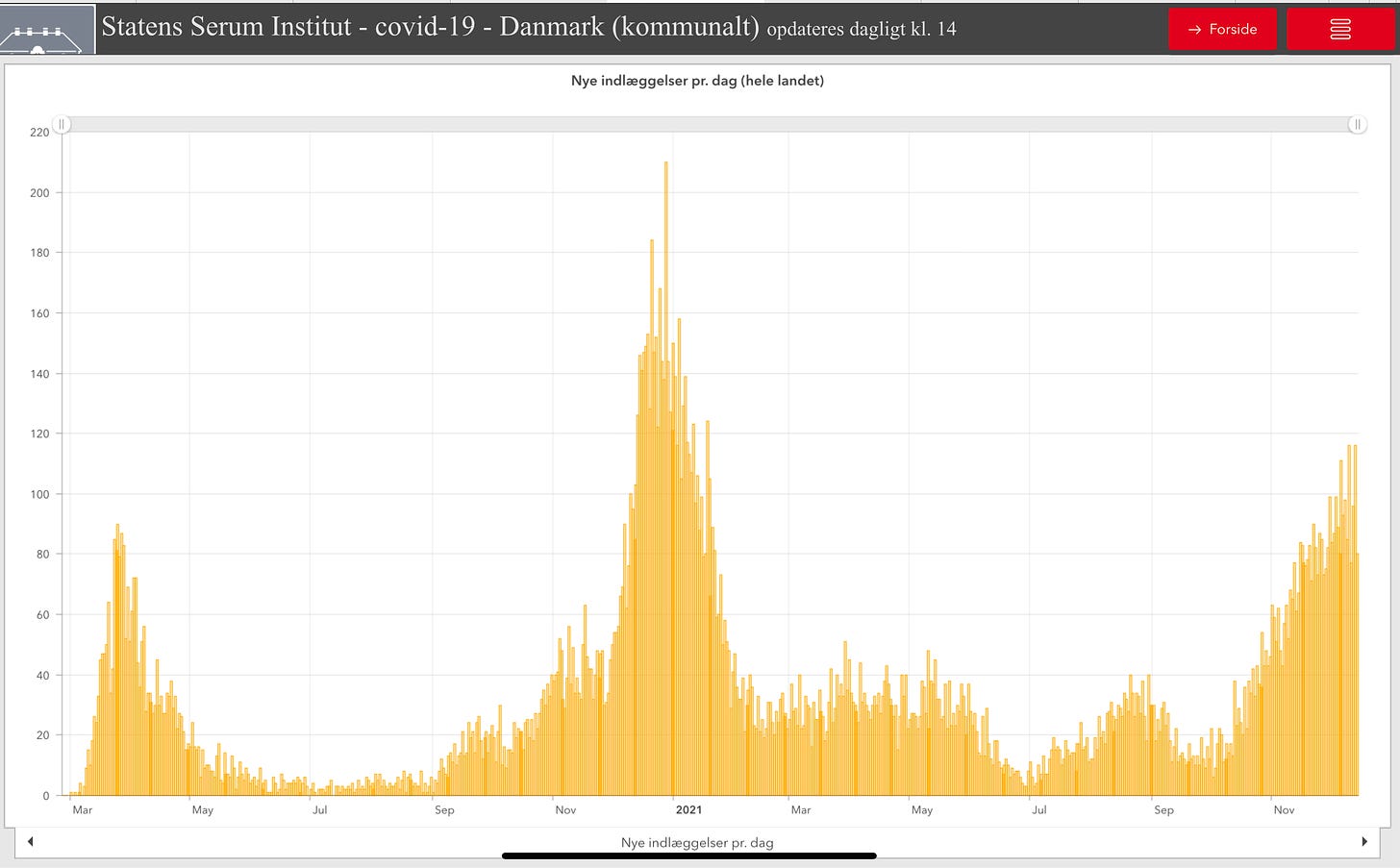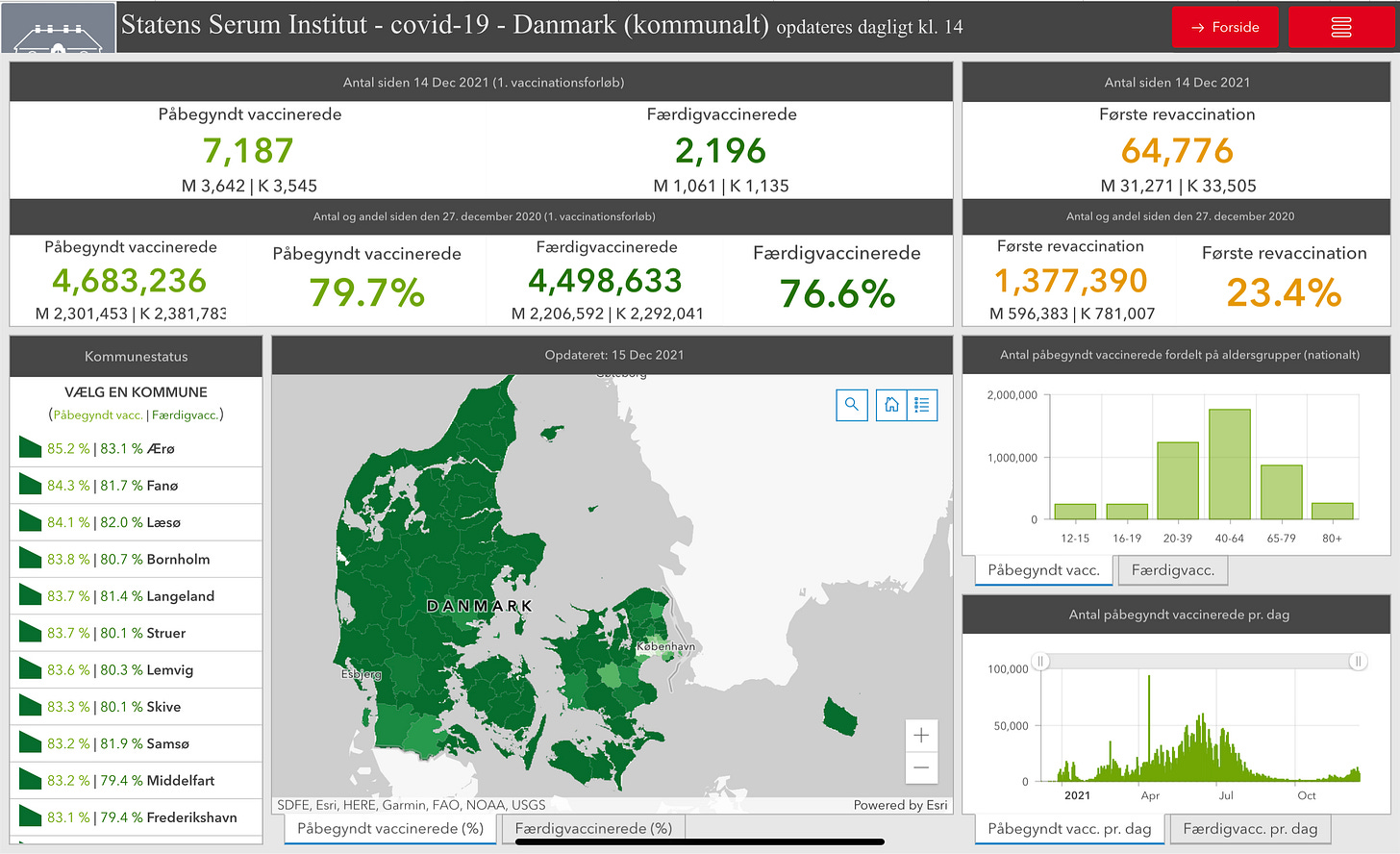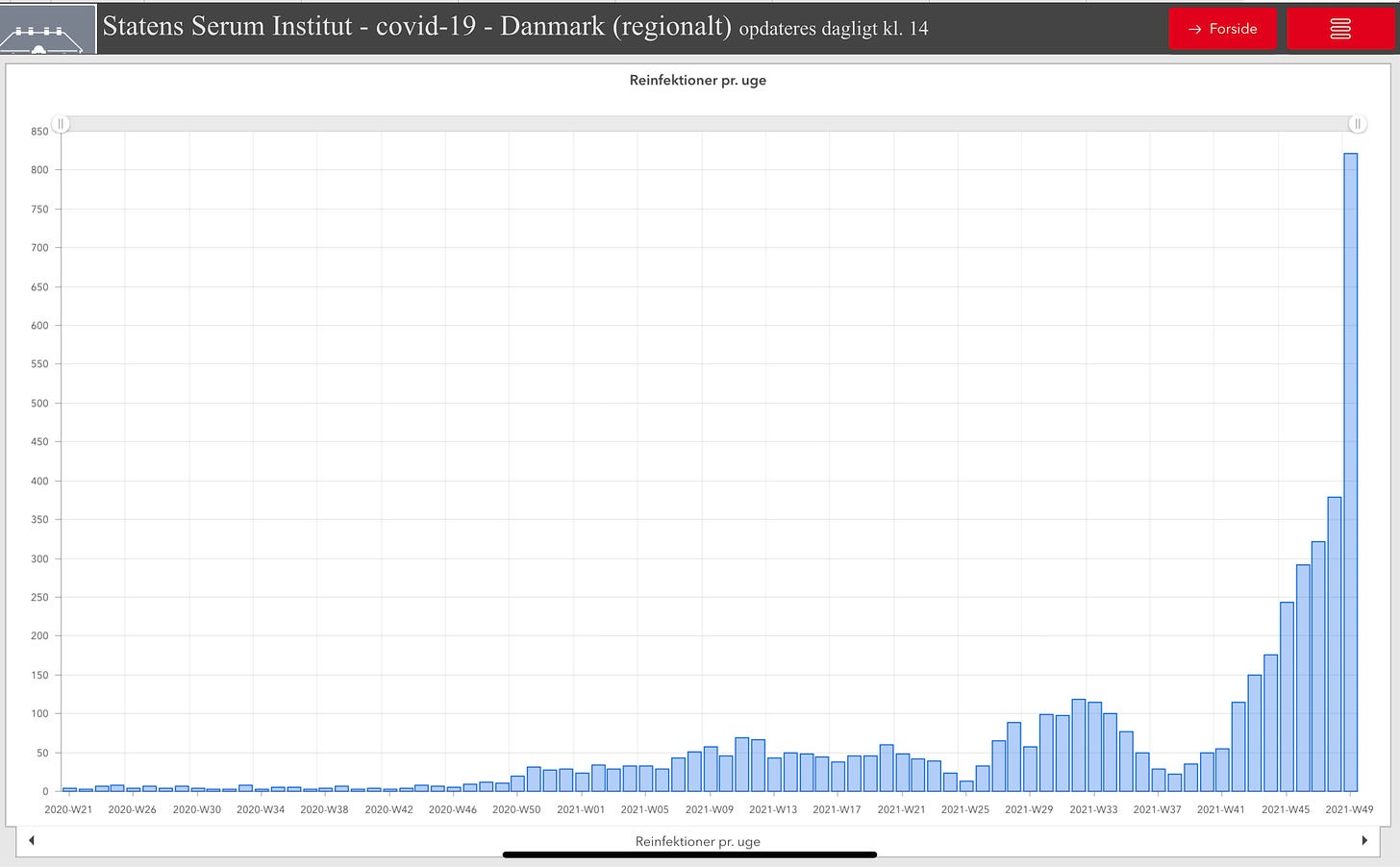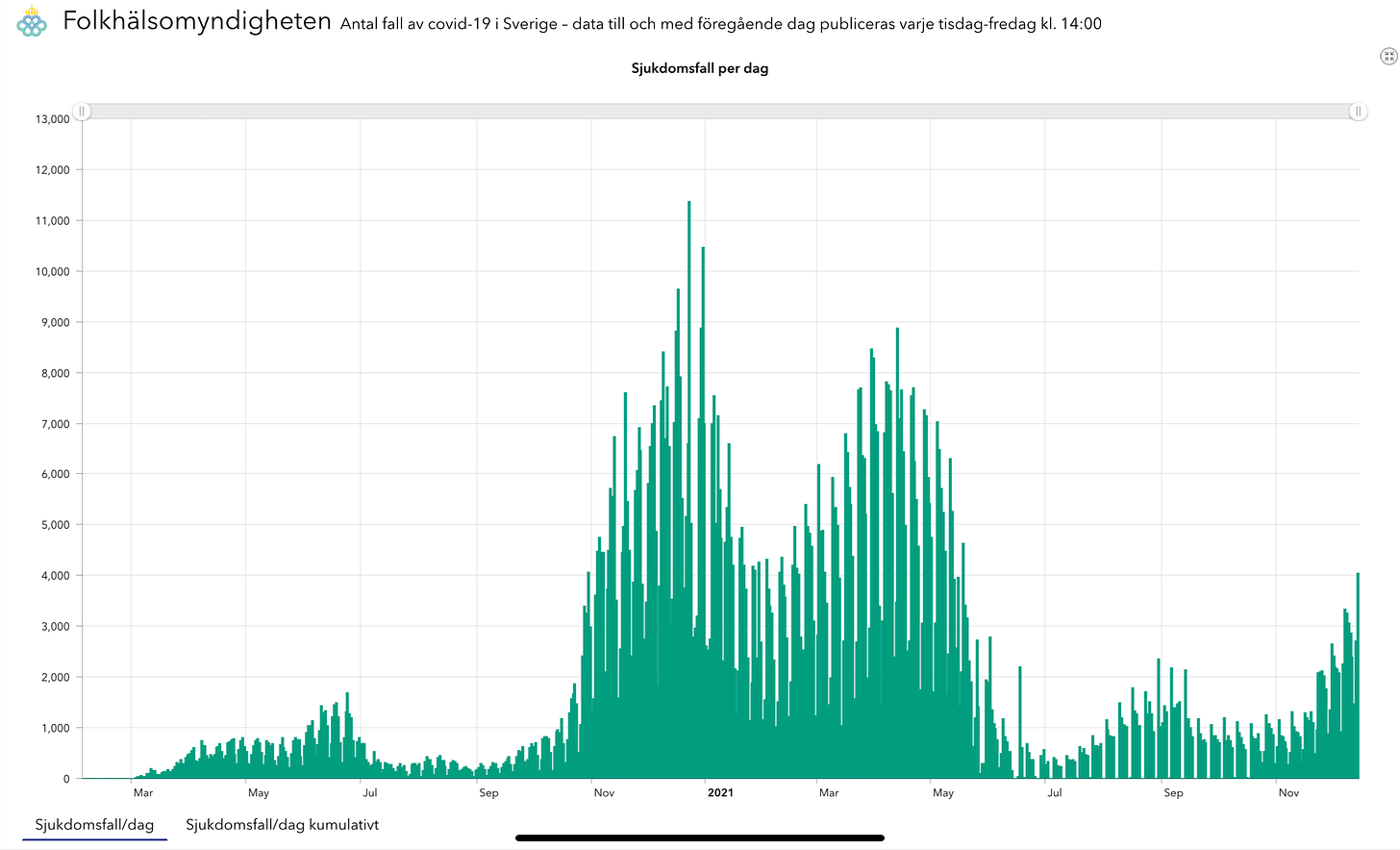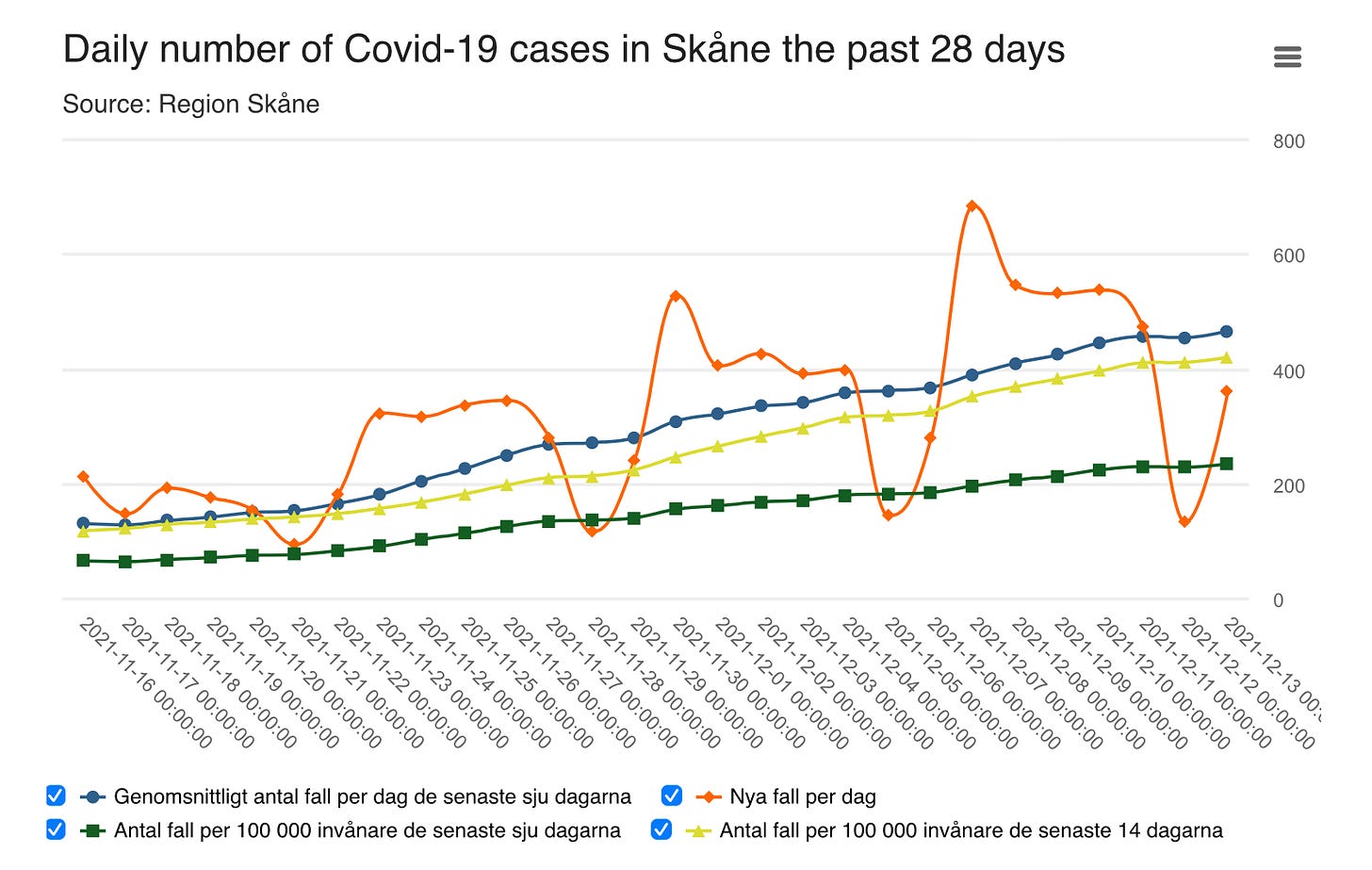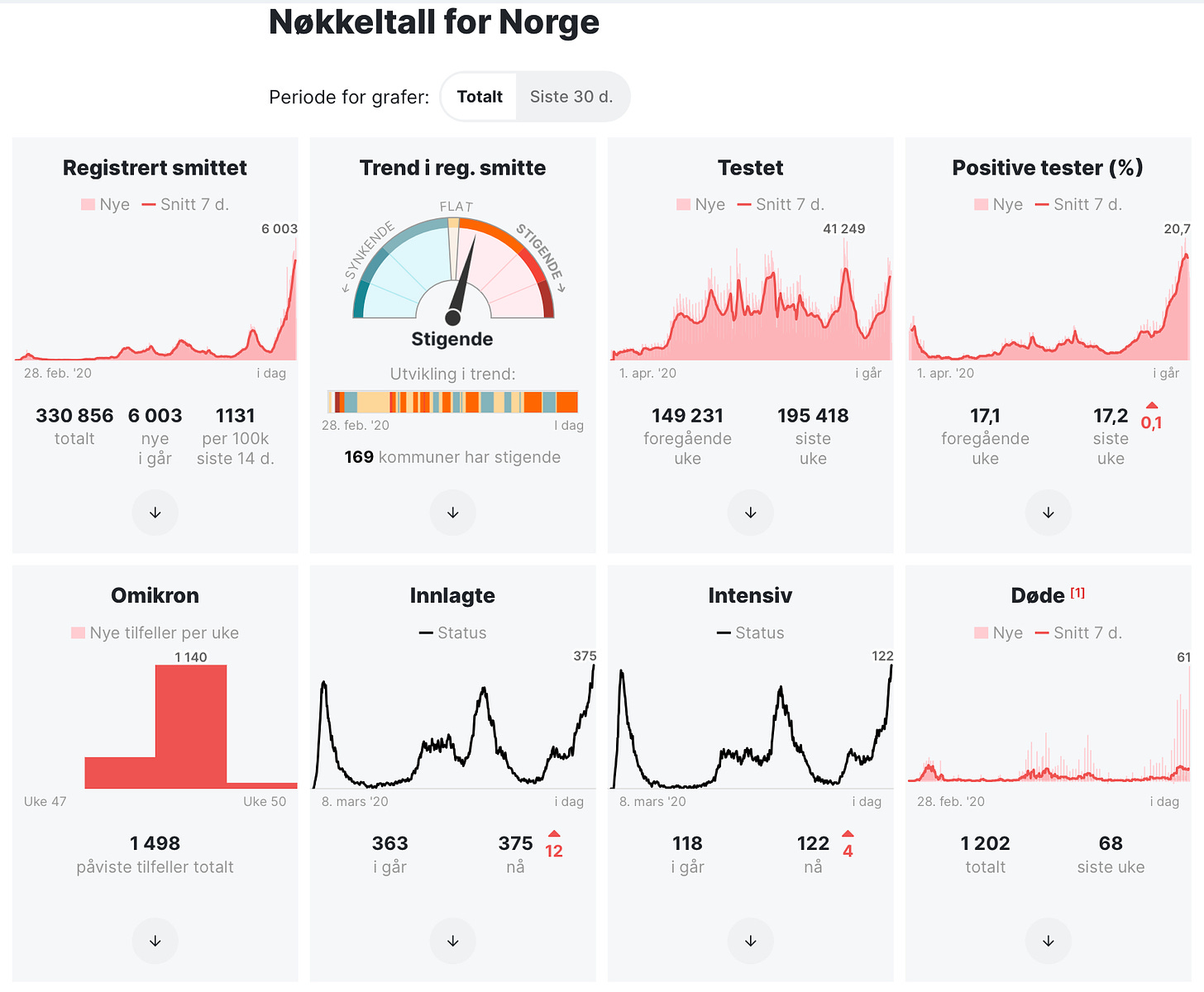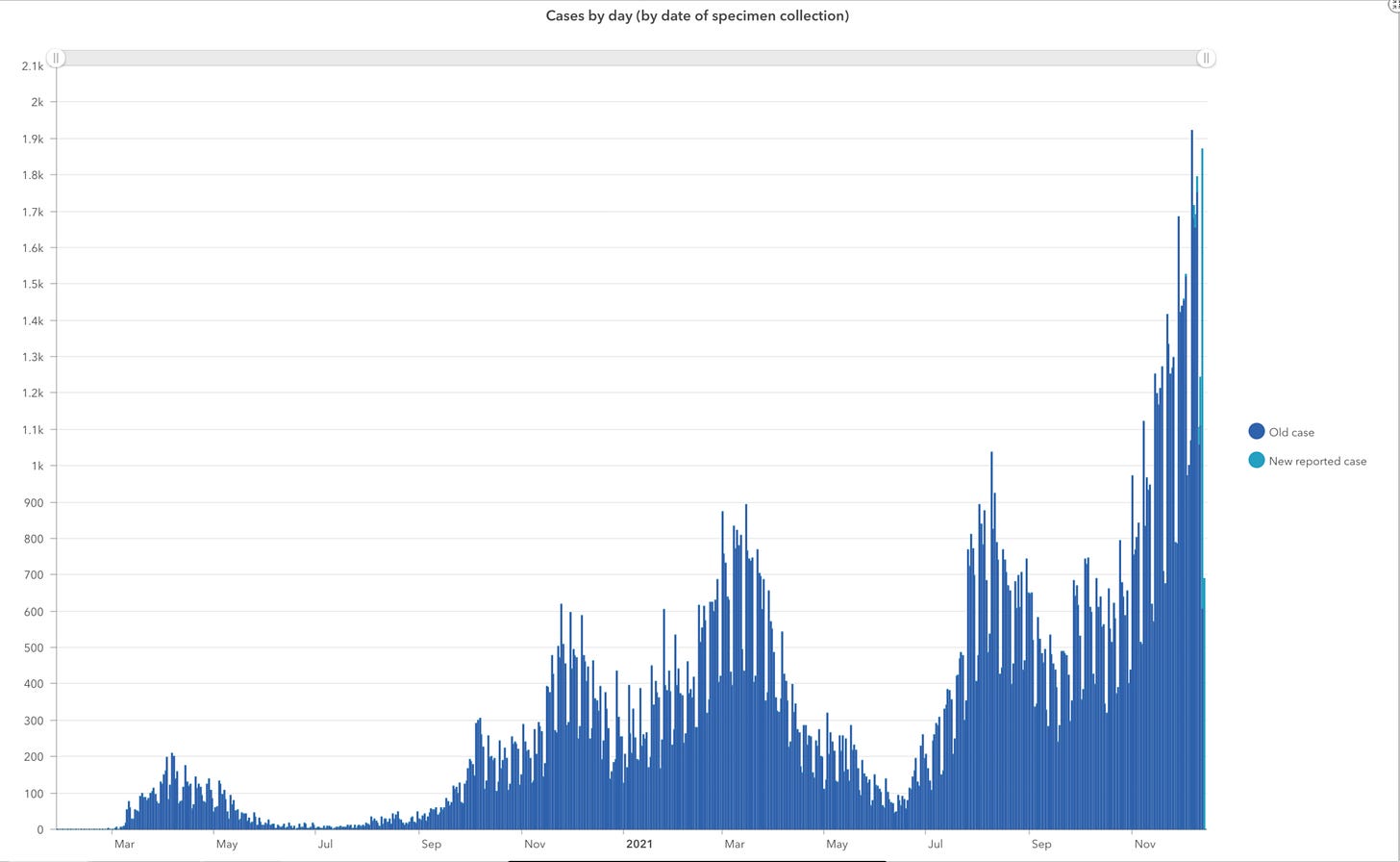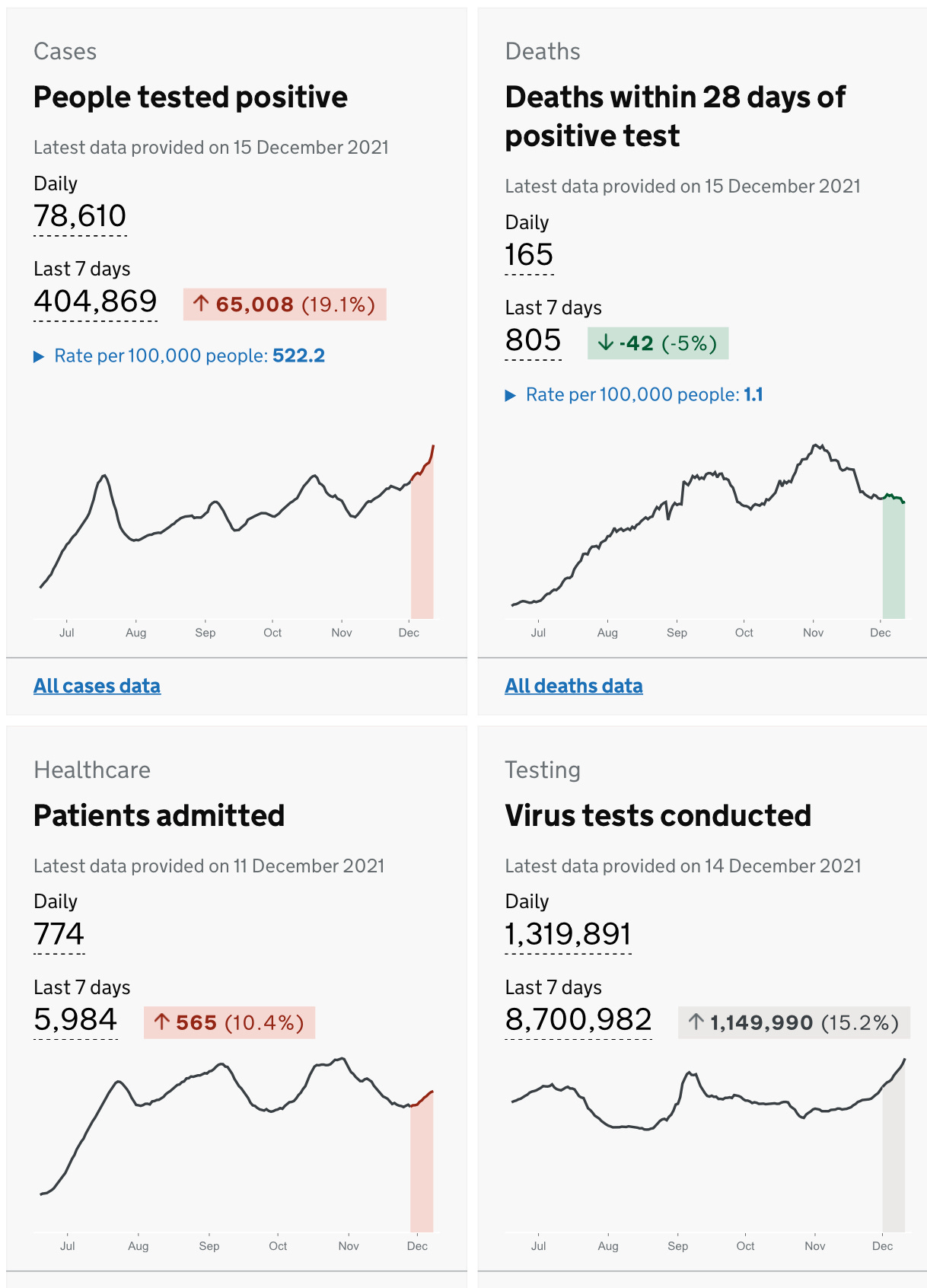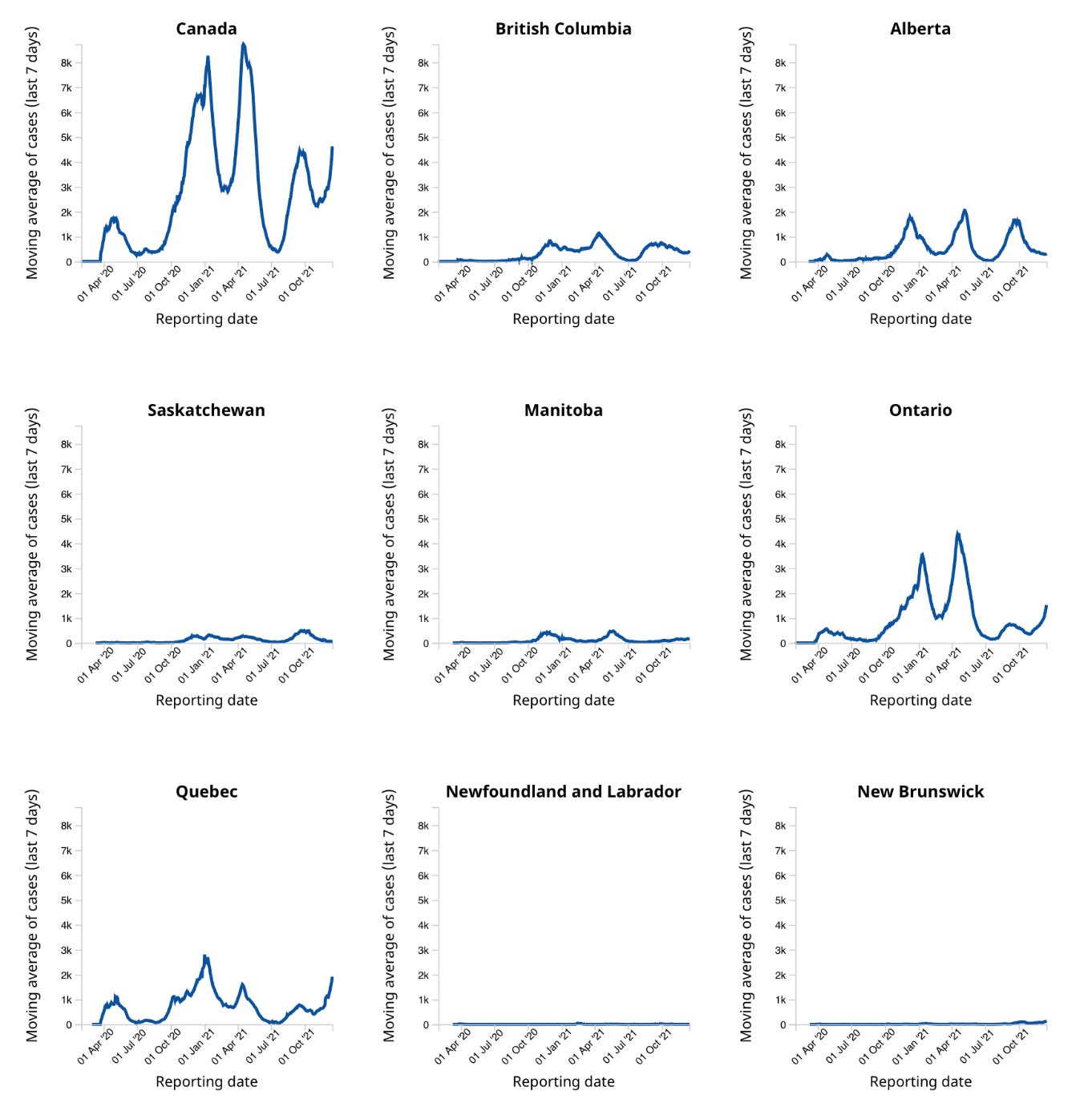🇩🇰
The number of Omicron variant cases continues to rocket upward, with the Staten Serum Institut reporting a total of 6,047 as of today, an increase of 1,512 variant infections in the last 24 hours. There have been 45 variant related hospitalizations, but there are fewer than 15 people currently in hospital. 78.5% of all Omicron infections to date have been among fully vaccinated people.
-
Health Minister Magnus Heunicke has informed DR that the Epidemic Commission is now assessing whether more restrictions are needed to wrestle down soaring infection numbers. COVID experts and severely Danish political parties have spoken in favor of leveling more restrictions.
-
COVID home testing kits are being made available over the Christmas break to students and staff in primary schools, private schools, and lower secondary schools who are not vaccinated or who have not been infected. The offer also applies to people working in daycares.
Anyone who qualifies can get one COVID take home test per week unless they live in an area deemed to have high infection risk, in which case two testing kits a week are allowed.
Minister for Children and Education Pernille Rosenkrantz-Theil:
“The message from the health authorities is clear: Omicron has changed the rules of the game. It is important that we use every option possible to get rid of the infection over Christmas, so we are ready to open schools in the new year.”
The testing kits have been made available for municipalities to distribute.
-
Denmark’s Ministry of Children and Education has tabled a back-to-school plan to try and ensure a safe return to school for students in the new year.
Minister Pernille Rosenkrantz-Theil:
“We have created a set-up to ensure that schools can stay open, even if the infection is high in society. It will be a slightly different everyday life, and the schools are once again faced with a task that requires extra effort. I'm convinced we'll get through it. I would once again urge parents to get their children vaccinated, because vaccinations are the most important weapon in the fight against infection.”
The back-to-school plan consists of a strong encouragement to parents to get their children five years old and up vaccinated.
Weekly COVID testing will be increased to twice a week for all students from grade one and up as well as staff. This applies regardless of vaccination status or having had a recent infection. This also applies to daycare staff.
The ministry has also tabled a number of recommendations for primary, independent, and private schools.
Teachers and students are to stay together and not mix with other classes.
SFO and other activities should be designed so that students are in regular groups.
Any major school events or social activities requiring students to mix across classes should be cancelled.
Social events like birthday parties, etc, should be confined to students in the same class.
Parents of students in primary schools should stay outside, dropping off and picking up their children. Should they go into school, they must wear a mask and ensure social distancing.
School staff who want to wear a mask or visor can.
All primary and lower secondary schools are to keep following guidelines on good ventilation of indoor spaces, ensure proper hand-washing for the kids, and keep surfaces cleaned.
-
For the 3rd day in a row Denmark is reporting a record high number of daily COVID infections with 8,773 today along with nine more coronavirus deaths.
Yesterday there were 460,325 total corona tests done, of which 205,222 were PCR tests equaling a positivity percentage of 4.27%.
As measured by the date of when a test was taken, Denmark has also set a new record high with 9,966 positive test results among tests taken on Monday, December 13.
-
COVID hospitalizations (508) continue to climb (+10) while the number of infected in an ICU (66) dropped slightly (-4) and of those the number on a ventilator (43) also edged downward (-3).
Hospitalizations haven’t exceeded 500 since last February.
-
On the vaccination front to date, there were 74,159 total inoculations yesterday, of which the most, 64,776, were booster doses. 7,187 people had a 1st dose on Tuesday..
To date, 79.7% of the total population have had one vaccine dose, 76.6% have had two, and 23.4% have had a booster shot.
-
The Red Cross is stepping in to offer some help to get Danish seniors vaccinated. A helpline has been set up (3529 9660) and volunteers will help elderly people book a vaccination appointment and get them down to a vaccination site.
Secretary General Anders Ladekarl:
“Maybe you live far away from your family, have trouble walking, or are worried about getting there alone. It can also be that you just have a hard time finding your way around a computer.”
On Wednesday, the Danish government decided to donate DKK 4.5 million to Red Cross relief efforts.
-
The Staten Serum Institut is now tracking the rate of reinfections, people who have had COVID or been vaccinated who get infected again. To date, the rate since vaccinations began last December is still low, almost 1% of everyone who has been vaccinated, but the agency says the number is rising. So far, there have been 5,233 reinfections spread across 5,175 people. So the vast majority have only been reinfected once, with a few unlucky ones dealing with several COVID infections now.
-
The Danish Royal Family has confirmed that Crown Princess Mary has tested positive for coronavirus. The Crown Princess is fully vaccinated and is in isolation. The Royal Family in a release says “no infection has been detected in other members of the family.”
🇸🇪
Sweden has added 4,044 infections and another 17 corona deaths since yesterday’s update.
So far, 7,689,518 1st vaccine doses (85.1% of the population aged 12 years old and older) and 7,299,620 2nd doses (80.8%) have been administered. Of those fully vaccinated 18 years old and older 1,849,731 booster doses have been administered (22.3%).
-
Region Skåne says it is seeing rising infection numbers and some degree of community spread of the new Omicron variant. The region in southern Sweden says COVID case numbers were up 26% last week compared to the week before. This comes along with an increase in testing indicating a concerning level of infection activity.
Infection Control Dr. Eva Melander:
“It is very good that so many self-tests are being done. But at the same time as testing increases, we also see that the proportion of positive results is increasing. This shows that we unfortunately have an increasing societal spread of COVID and at the same time the burden on healthcare is gradually increasing.”
The region says most of the infection activity is among those under the age of 60. The largest increase in infections is among school age children. The region is also seeing COVID spread at various gatherings, including in workplaces and at conferences.
“As an individual, you should take responsibility and keep your distance in public environments, and avoid crowded environments. If you have the opportunity to work from home - do it. For businesses and employers, it is important to ensure that employees have the opportunity to keep their distance, maintain good hand hygiene, and to avoid large gatherings indoors. Think about what is appropriate and use your judgment and make decisions accordingly. Last but not least, stay home when you feel sick. This applies to all types of contexts and also for travel.”
Health officials in Region Skåne have confirmed 25 cases of the Omicron variant so far. Some of those are linked to international travel, but there are cases with no links to any trips abroad indicating some degree of community spread.
-
Sweden’s Region Halland has confirmed its first case of the Omicron variant. The region is awaiting genome sequencing results on eight more suspected variant cases.
-
COVID wastewater monitoring in the city of Gothenburg has seen a “sharp increase” in virus traces in the last week with coronavirus amounts tripling.
Microbiology Professor at the Sahlgrenska Academy, Heléne Norder, spoke to the newspaper Dagens Nyheter.
“They aren’t at disaster levels yet, but it is unfortunately going up in Gothenburg.”
🇳🇴
Norway has added 5,718 infections and suffered another 61 pandemic deaths since yesterday’s update.
Norway has recorded 1,498 total Omicron variant infections so far.
COVID hospitalizations (375) are up (+12) while the number of infected people in a. ICU (122) also inched up (+4).
To date, 79% of Norwegians 12 years old and older have had one vaccine dose, 72% have had two, and 19.7% have had a booster dose.
-
Pediatric doses of the Pfizer/BioNTech vaccine have arrived in Norway this week and vaccinations of some children aged five to 11 years old will begin soon. The Norwegian Institute of Public Health says only children with underlying health issues will be vaccinated right now. Studies are still underway to determine if Norway will green-light a full vaccination program for all five to 11 years olds. The NIPH estimates about 3,000 kids in the age group meet the high risk criteria.
Chief Physician Margrethe Greve-Isdahl:
“The offer goes to a small group of children who already have a very serious illness, such as those with cancer, organ transplants, those who have severe immune deficiency, severe and complex neurological diseases, or congenital syndromes. These children can benefit from the protection the vaccine provides.”
Norwegian health authorities are leaving it up to family doctors and pediatricians to “on their own initiative” identify children considered to be high-risk who should be vaccinated.
-
Norway has reached a bilateral agreement with pharmaceutical company Merck Sharp & Dohme for 8,640 of its COVID treatment pills using the antiviral drug molnupiravir. The pills will arrive before Christmas but Norwegian health authorities will hold off using the pills, at least for now, until the European Medicines Agency approves use of the COVID treatment pill in Europe. But as Norway struggles with record high infection numbers and rapidly spreads Omicron cases “the Norwegian Directorate of Health is considering this on an ongoing basis.”
🇫🇮
Finland has registered a record high 2,225 infections and two more virus deaths in the last day.
COVID hospitalizations (314) are up (+18).
To date, 76.9% of the total population have had one vaccine dose, 73% have had two, and 10.1% have had a booster dose.
-
The Finnish Institute for Public Health confirmed another 11 Omicron variant infections cases on Wednesday. Confirmed cases of the new variant have so far been found in the Hospital District of Helsinki and Uusimaa (HUS), South Karelia Social and Health Care District (Eksote), as well as the Hospital Districts of Southwest Finland and Vaasa. So far, most of the Omicron cases in Finland are related to travel.
-
Finland has begun vaccinating young children aged five to 11 years old, but on,y those considered to be high-risk. The Finnish Institute for Public Health says it has issued guidelines for municipalities so they can begin vaccinations of at risk groups “as soon as arrangements are made.”
Leading Expert Mia Kontio:
“Municipalities will inform when vaccinations for at-risk 5–11-year-olds can start and where vaccinations can be done. In principle, vaccinations can be started immediately, but practical arrangements can take a while at the municipal level.”
-
Like Denmark and Norway, it is all hands on deck for the vaccination effort in Finland. The Helsinki and Uusimaa Hospital District is putting out a call for all retired medical professionals, students, and former healthcare workers to help get more needles into arms to speed up administering booster doses. Staffing shortages in Finland are hindering the vaccination effort.
Acting Chief Medical Officer Jari Petäjä!
“We hope that, for example, healthcare professionals who are retired, on leave or engaged in other work, as well as students in the field, will help administer vaccines, even for a short period.”
🇪🇺🦠
The European Centre for Disease Prevention and Control has updated its Omicron variant threat assessment and it is recommending much stronger restrictions to prevent disaster. The European health agency says its modeling shows that the new variant will become dominant across the European Union and European Economic Area within the first two months of the new year. It rates the risk posed by exploding Omicron numbers across Europe and the threat to public health as ‘Very High.’
The ECDC says the jury is still out on how severe, or not, the Omicron variant is as there is simply not enough evidence to draw a conclusion yet.
“However, even if the severity of disease caused by the Omicron variant is equal to or lower than the severity of the Delta strain, the increased transmissibility and resulting exponential growth of cases will rapidly outweigh any benefits of a potentially reduced severity. It is therefore considered very likely that the Omicron VOC will cause additional hospitalisations and fatalities, in addition to those already expected in previous forecasts that only take into account the Delta variant.”
In order to try and slow down the spread of the Omicron variant and prevent an unmanageable infection wave swamping hospitals and other resources, the ECDC says there needs to be a “strong and immediate” reduction in social contacts. It says COVID restrictions need to be strengthened “without delay.” This would include wearing masks, avoiding large gatherings, reducing social contacts, working from home, and increased testing and contact tracing. The agency is also asking EU countries to advise against travel and gatherings during the holiday season. It also urges countries to undertake immediate planning to increase hospital capacity to handle a major influx of COVID patients.
It warns without strengthening COVID restrictions and drastically reducing social contacts infection numbers “could rapidly overwhelm EU/EEA healthcare systems.”
While the ECDC reports a “slow increase” in vaccine uptake across Europe in recent weeks, overall uptake is still woefully inadequate. As of December 9 it says cumulative fully vaccine uptake across the EU/EEA is just 66.8%. Four countries in Europe have vaccination coverage of less than 50%. While available evidence shows reduced effectiveness of two vaccine doses against the Omicron variant, the health agency says there is still “insufficient real-life data.” It says available evidence points to booster doses increasing protection against the variant. It says data shows it is “safe and effective” to reduce the interval between a 2nd and 3rd dose to three months.
🇬🇧
As the United Kingdom struggles with exploding numbers of Omicron variant infections, it has reported a record high 78,610 infections today, along with 165 corona deaths.
There were 774 new hospital admissions Wednesday as overall hospitalizations in the last seven days have increased.
England’s Chief Medical Health Officer Professor Chris Whitty said the worst has yet to come.
“I am afraid we must be realistic, that records will be broken many times over the next few weeks.”
🌍💉
Moderna has tabled data on the efficacy of its COVID vaccine against the new Omicron variant. The vaccine maker says the two doses resulted in “significantly lower” neutralization against the variant. But, it says a booster dose (1/2 a regular dose) provided “significantly increased neutralizing antibodies” against Omicron. Moderna says it is working on a “three-part strategy” to deal with the variant and is expecting more results from a full booster dose and its ‘multi-valent’ vaccine in the coming week.
🇨🇦
The Canadian government has issued an advisory asking Canadians not to travel outside the country due to a global Omicron variant wave. It is also looking to ramp up testing for all incoming travelers at airports.
-
Canada’s COVID numbers keep heading up as it reported 5,810 new infections and 25 more deaths on Wednesday. Major increases in Ontario and Quebec are driving the national infection curve skyward.
On the vaccination front to date, 31,211,650 1st vaccine doses (81.63% of the total population) have been administered while 29,233,072 people (76.45%) are now fully vaccinated. Of those, 3,437,428 people have received a booster dose.
In Ontario Wednesday there were 1,808 infections, the highest COVID count in months, and nine more deaths. There are 357 people in hospital, of which 273 are either not fully vaccinated or not vaccinated at all. Of the 154 people in intensive care, 84 had either one vaccine dose or none at all. The province is increasing the eligibility for booster doses and leveling a number of measures including capping attendance at major sporting events to combat the spread of the Omicron variant.
Quebec reported its highest number of daily infections in almost a year, with 2,386.
In Atlantic Canada, Nova Scotia has 178 new infections. New Brunswick has 16” new corona cases, of which 11 are the Omicron variant. Newfoundland and Labrador had 13 infections and confirmed its first Omicron case.
Manitoba saw 206 new corona cases and two more deaths. The province has unveiled modeling showing the Omicron variant could soon drive daily cases past the 1,000 mark.
There were 62 infections in Saskatchewan with no new deaths.
Alberta registered 456 new COVID cases and three more deaths. There are 291 people in hospital, of which 62.9% are either unvaccinated or have a single dose. Of the additional 71 in intensive care, 74.6% have either one dose or none at all.
B.C. logged 584 new COVID cases and 7 more deaths. 193 people are in hospital, with 77 in intensive care.




